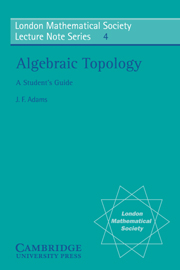Book contents
- Frontmatter
- Contents
- INTRODUCTION
- PAPERS ON ALGEBRAIC TOPOLOGY
- 1 Combinatorial homotopy
- 2 An axiomatic approach to homology theory
- 3 La suite spectrale. 1: Construction générale
- 4 Exact couples in algebraic topology
- 5 The cohomology of classifying spaces of H-spaces
- 6 Cohomologie modulo 2 des complexes d'Eilenberg-MacLane
- 7 On the triad connectivity theorem
- 8 On the Freudenthal theorems
- 9 The suspension triad of a sphere
- 10 On the construction FK
- 11 On Chern characters and the structure of the unitary group
- 12 Espaces fibrés et groupes d'homotopie. I, II
- 13 Generalised homology and cohomology theories
- 14 Relations between ordinary and extraordinary homology
- 15 On axiomatic homology theory
- 16 Characters and cohomology of finite groups
- 17 Extract from thesis
- 18 Relations between cohomology theories
- 19 Vector bundles and homogeneous spaces
- 20 Lectures on K-theory
- 21 Vector fields on spheres
- 22 On the groups J(X). IV
- 23 Summary on complex cobordism
20 - Lectures on K-theory
Published online by Cambridge University Press: 23 May 2010
- Frontmatter
- Contents
- INTRODUCTION
- PAPERS ON ALGEBRAIC TOPOLOGY
- 1 Combinatorial homotopy
- 2 An axiomatic approach to homology theory
- 3 La suite spectrale. 1: Construction générale
- 4 Exact couples in algebraic topology
- 5 The cohomology of classifying spaces of H-spaces
- 6 Cohomologie modulo 2 des complexes d'Eilenberg-MacLane
- 7 On the triad connectivity theorem
- 8 On the Freudenthal theorems
- 9 The suspension triad of a sphere
- 10 On the construction FK
- 11 On Chern characters and the structure of the unitary group
- 12 Espaces fibrés et groupes d'homotopie. I, II
- 13 Generalised homology and cohomology theories
- 14 Relations between ordinary and extraordinary homology
- 15 On axiomatic homology theory
- 16 Characters and cohomology of finite groups
- 17 Extract from thesis
- 18 Relations between cohomology theories
- 19 Vector bundles and homogeneous spaces
- 20 Lectures on K-theory
- 21 Vector fields on spheres
- 22 On the groups J(X). IV
- 23 Summary on complex cobordism
Summary
In these two lectures on K-theory I shall:
(i) Give the elementary proof (due to Atiyah and Bott) of the Bott periodicity theorem.
(ii) Develop the basic machinery of K-theory (using Dold's lectures on half-exact functors) and show how Adams and Dyer have applied it to obtain Adams' result on the nonexistence of elements of Hopf invariant one.
I shall under (i) only give the surjectivity of the Bott homomorphism whereas the injectivity is obtained under (ii) from ‘general nonsense’. This shortens the exposition. For the full elementary proof see the notes of Atiyah and Bott distributed during this Summer Institute.
Vector bundles on X and vector bundles on X × S2
Let X be a compact topological space. We shall prove the Bott periodicity theorem by examining the relationship between complex vector bundles on X and complex vector bundles on X × s2. A complex vector bundle may have different fibre dimensions over the various connectedness components of its base space. We consider S2 as C ∪ ∞ and S1 as {z ∥ z ∣ = 1}.
If E is a complex vector bundle on X, Ex denotes the fibre of E at x ∈ X. A clutching function for E is a function p which continuously assigns to each (x, z) ∈ X × S1 an automorphism p(x, z) of Ex. An endomorphism of E is a function a which continuously assigns to each x ∈ X an endomorphism a(x) of Ex. a is an automorphism of E if a(x) is non-singular for x all x ∈ X.
- Type
- Chapter
- Information
- Algebraic TopologyA Student's Guide, pp. 223 - 238Publisher: Cambridge University PressPrint publication year: 1972
- 1
- Cited by



